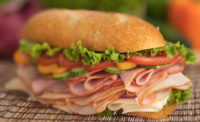Fall and winter are particularly busy times for many small meat processors who process venison. Venison processing is an important part of their yearly business and contributes significantly to their bottom line.
Meat processors receive venison in a variety of forms; whole carcasses either skinned or unskinned, bone-in pieces of venison and boneless venison. I suggest you establish a policy of what forms you will accept. I like either carcasses that have been eviscerated but not skinned or boneless venison. When receiving carcasses that have not been skinned, skin the carcass then trim any contamination such as bruises or damaged meat prior to thoroughly washing the carcass. After letting the carcass drip for a few minutes it is advisable to then spray it with the same antimicrobial solution you use on beef carcasses.
I do not like receiving carcasses that have been skinned because often the outside of the carcass has been contaminated. I think it is unwise to accept carcasses that have not been eviscerated. I also do not like bone-in cuts because they can be awkward to store and take up extra space while awaiting processing. Post your policies in your plant and on your website and make them well known to your customers. These handling measures are important because, while today’s typical consumer likes meat products that are convenient and easy to prepare and are willing to pay for the convenience of such products, they also want meat products that are safe.
Most venison processing customers like a variety of raw and processed products. Make sure each package of product is the appropriate weight for your customer. Label all packages with a description of what is inside and the date it was processed. Nicely packaged and labeled products serve as positive advertisement for your business each time a customer gets a package out of their freezer. Poorly wrapped and labeled packages present a negative image for your company.
When processing venison product I trim off the majority of the game fat. Consequently, I like to add some beef or pork trim during processing. A target of 20-30% fat is desirable in raw ground products. This yields products that are flavorful and juicy but not overly greasy. Let customers know your target percent fat in finished products. Offer your customers a choice between a variety of fresh ground products. Some specialty flavored ground product you might consider are; taco, chorizo, Italian sausage, and hot Italian sausage. These types of ground products provide your customers with the opportunity to easily prepare a variety of cooked items. Another venison product I really like is venison meat loaf. You can prepare a ready-to-cook meat loaf mix and package it in 1 lb. or 3 lb. disposable aluminum pans. It make a great, easy-to-prepare meal for your customers.
There are many different cooked venison products you can offer your customers. Some popular items are smoked sausage, ring bologna, summer sausage, snack sticks and jerky. These can be manufactured in a variety of flavors with a variety of inclusions. In the interest of safety, I like to process cooked venison products to 170˚F internal. This helps to assure your products are free of pathogens and that a high percentage of the spoilage organisms, often present on venison, have been killed. The end result is safe products that store well.
Remember: Don’t forget to pause and enjoy a fall cookout.








Report Abusive Comment